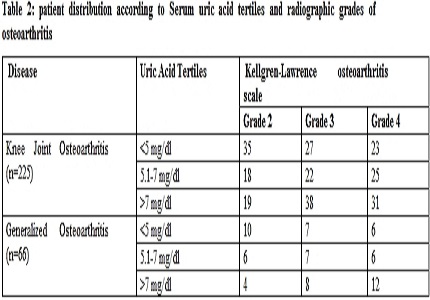A prospective study on association of serum uric acid level with knee osteoarthritis
Abstract
Background: A numbers of studies have described a relationship among serum uric acid level and generalized osteoarthritis in recent past, but studies on evidence of relationship among serum uric acid and knee joint osteoarthritis are limited. Present study is intended to validate the association between serum uric acid levels and osteoarthritis of kne joint.
Methods: This is a prospective study including three hundred forty patients (225 males, 115 females) with clinically diagnosed osteoarthritis of knee. Patient’s radiographs of affected knees and hands were obtained along with their serum uric acid level, Rheumatoid factor and C reactive protein level. Keligren-Lawrence osteoarthritis scale was used for grading of knee osteoarthritis roentgenographically. On the basis of serum uric acid levels, all the patients were divided in to three groups acoording to serum uric acid level Group 1: - serum uric acid less than 5mg/dl, Group 2: - serum uric acid levels between 5.1-7 mg/dl, Group 3: - serum uric acid levels greater than 7 mg/dl.
Results: Out of 340 patients, 238 patients (70 %) dignosed as isolated knee joint osteoarthritis, generalized osteoarthritis is seen in 66 (19.6 %) patients, and Rheumatoid Factor, along with C-reactive protein is positive in 36(10.5%) patients. Association of osteoarthritis of knee joint, generalized osteoarthritis with the highest tertile of serum uric acid level found to be strongly positive [adjusted odds ratio- 2.31 and adjusted odds ratio- 3.27 respectively). Also association between increasing serum uric acid levels and progression of the osteoarthritis of knee found to be positive.
Conclusion: This study supports a possible correlation between hyperuricemia and osteoarthritis. also a positive association of knee joint osteoarthritis, generalized osteoarthritis progression with increasing uric acid level is suggested.
Downloads
References
2. Davis MA, Ettinger WH, Neuhaus JM. The role of metabolic factors and blood pressure in the association of obesity with osteoarthritis of the knee. J Rheumatol. 1988 Dec;15(12):1827-32. [PubMed]
3. Felson DT, Anderson JJ, Naimark A, Walker AM, Meenan RF. Obesity and knee osteoarthritis. The Framingham Study. Ann Intern Med. 1988 Jul 1;109(1):18-24. [PubMed]
4. Bagge E, Bjelle A, Edén S, Svanborg A. Factors associated with radiographic osteoarthritis: results from the population study 70-year-old people in Göteborg. J Rheumatol. 1991 Aug;18(8):1218-22. [PubMed]
5. Schouten JS, van den Ouweland FA, Valkenburg HA. A 12 year follow up study in the general population on prognostic factors of cartilage loss in osteoarthritis of the knee. Ann Rheum Dis. 1992 Aug;51(8):932-7. [PubMed]
6. Hart DJ, Spector TD. The relationship of obesity, fat distribution and osteoarthritis in women in the general population: the Chingford Study. J Rheumatol. 1993 Feb;20(2):331-5. [PubMed]
7. Hart DJ, Doyle DV, Spector TD. Association between metabolic factors and knee osteoarthritis in women: the Chingford Study. J Rheumatol. 1995 Jun;22(6):1118-23. [PubMed]
8. Kono H, Chen CJ, Ontiveros F, Rock KL. Uric acid promotes an acute inflammatory response to sterile cell death in mice. J Clin Invest. 2010 Jun;120(6):1939-49. doi: 10.1172/JCI40124. Epub 2010 May 24. [PubMed]
9. Acheson R, Collart AB. New Haven survey of joint diseases XVII: Relationship between some systemic characteristics and osteoarthritis in a general population. Ann Rheum Dis, 1975. 34(5): p. 379-87. [PubMed]
10. Roddy E, Zhang W, Doherty M. Are joints affected by gout also affected by osteoarthritis? Ann Rheum Dis. 2007 Oct;66(10):1374-7. Epub 2007 Feb 6. [PubMed]
11. R N Sarkar, Kuntal Bhattacharyya et al. Gout – updated 2012 Medicine Update Vol. 22: 674-79 DOI: http://dx.doi.org/10.1016/S0973-3698(11)60025-3. [PubMed]
12. Kellgren JH, Lawrence JS. Radiological assessment of osteo-arthrosis. Ann Rheum Dis. 1957 Dec;16(4):494-502. [PubMed]
13. Ruggiero C, Cherubini A, Ble A, Bos AJ, Maggio M, Dixit VD, Lauretani F, Bandinelli S, Senin U, Ferrucci L. Uric acid and inflammatory markers. Eur Heart J. 2006 May;27(10):1174-81. Epub 2006 Apr 12. [PubMed]
14. Denoble AE, Huffman KM, Stabler TV, Kelly SJ, Hershfield MS, McDaniel GE, Coleman RE, Kraus VB. Uric acid is a danger signal of increasing risk for osteoarthritis through inflammasome activation. Proc Natl Acad Sci U S A. 2011 Feb 1;108(5):2088-93. doi: 10.1073/pnas.1012743108. Epub 2011 Jan 18.
15. Al-Afraj AS. Serum uric acid and radiographic osteoarthritis. J Pak Med Assoc. 2003; 53(5):187-9.
16. Misra A, Khurana L. Obesity and the metabolic syndrome in developing countries. J Clin Endocrinol Metab. 2008 Nov;93(11 Suppl 1):S9-30. doi: 10.1210/jc.2008-1595.



 OAI - Open Archives Initiative
OAI - Open Archives Initiative


